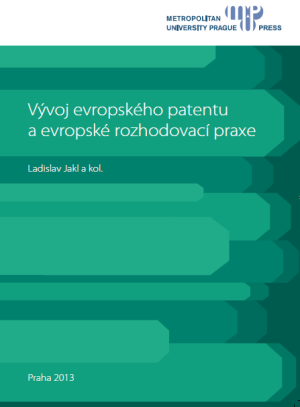JAKL, Ladislav a kol. Vývoj evropského patentu a evropské rozhodovací praxe.

Prague: Metropolitan University Prague Press, 2013. 242 s. ISBN 978-80-86855-93-6
During the academic year 2012-2013, the scientific and research activity of the Department of Industrial Property and the Institute for legal protection of industrial propety of Metropolitain University Prague, o.p.s., has focussed on the preparation of the basis for our own lecturing in the bacchelor (Bc.), magister (Mgr.) and doctorate (Ph.D.) study fields, and on resolving problems currently becoming very real and whose resolution requires as well the creation of theoretic fundaments. To these substantial problems belong issues related to the preparation of the European "Patent with unitary effect" and the "Unified Patent Court" and with the evolution of European decision praxis about industrial rights. Therefore, the scientific and research activity was oriented in this direction. The presented collective monograph includes contributions dealing with the establishment of the European Patent with the unitary effect and the Unified Patent Courts per se, as well as with European case law in the field of trademarks, industrial designs and patents and their influence on the decisions of the Czech Industrial Property Office. Since the group of authors includes as well important experts from the Slovak Republic, which concentrate on the influence of the European case law, the impact on decisions of the Slovek Industrial Property Office is incorporated also.
Due to contributions about the establishment of the „Patent with unitary effect" and the „Unified Patent Court“, this monograph concerns itself with analyizing the evolution of solutions linked to the creation of these institutions during the last decades, i.e. until the acceptance of the so called "Patent package" by the member states of EU and European Parliament in 2012. This is a result of a legislative initiative consisting of two EU Regulations and an International Agreement which led to the establishment of fundaments for the introduction of the unified patent protection in the EU. The accession of EU member states to the signature of the Agreement on the Unified Patent Court - to the third and last part of the "patent package" - resulted in the foundation for a unified jurisdiction in this field. Authors of contributions, Ing. Mgr. Josef Kratochvíl and JUDr. Světlana Kopecká, concentrated not only in analyzing this very complex issue, but as well in implying theoretic conclusions which forecast the evolution in the following years, especially after the entry into validity of the Agreement on the Unified Patent Court. Thus at the earliest commencing on 1st January 2014, or rather since the 1st day of the 4th month following the deposition of the 13th ratification document about the accession (provided that there are among them ratification documents from France, Germany and Great Britain). The analysis of conditions emerging after the completion of these fundamental steps can be considered as very useful as well. This part of the collective monograph is terminated by a truly beneficial theoretic contribution by doc. JUDr. Vladimír Pítra, which analyzes the patent proceedings after the recodification of the Private law and thus becomes an appropriate fundament for its application while resolving questions related to the evoluation in this field.
The second group of articles is oriented towards an analysis and comparison of Czech, Slovak and European case law in the field of industrial property and creates a foundation for the application in deciding about the legal protection of designation, designs and trademarks. The contribution by prof. JUDr. Peter Vojčík, CSc., deals with a court review of the decisions of the Slovak Industrial Property Office, considers various questions from the point of view of a general legal approach and provides the possibility of a comparision with the current Czech situation. Based on her many years valuable experience with the work of the Slovak Industrial Property Office and on her contacts with the Office for Harmonization in the Internal Market in Allicant, Ing. Darina Kyliánová presents an in-depth analysis on the impact of the operation of this European trademark and design office on decisions of the Slovak Industrial Office. Her contribution includes examining several European decisions and their influence on decision making on the national level. This contribution is followed by a study presented by JUDr. Vladimír Zamrzla about decisions of the Court of Justice of the EU. The article analyzes the role of the law and judicial decisions of the EU and their consequences for national proceedings, especially in relation to trademarks. He points out the databases of the EU judicial decisions and covers the classification of of the Communitaire organs.
The remaining group of contributions are oriented towards questions linked to deciding about patents and industrial designs. The study of Ing. Emil Jenerál is dedicated to decisions of the review panels of the European Patent Office and their impact on Czech decision making. He employs his rich and extensive theoretic and practic experience, which he earned during many years when he concentrated on questions about the legal protection of inventions and utility models on the European level. The concluding contribution is prepared Jiří Effmert, a prominent patent and trademark agent and deals with the definition of the informed user, which is used during the resolution of disputes in the field of breach of rights to Community industrial design. This part is very interesting for the theoretical as well as practical sphere, especially because in the last years it has increased the frequency of obtaining rights to industrial designs from the Office for Harmonization in the Internal Market.
Generally, it can be summarized that the indicated group of experienced authors, assembled in the Institute for legal protection of industrial property and the Department of Industrial Property presents in this collected monograph valuable contributions which assist in the solution of emerging problems in this area.



